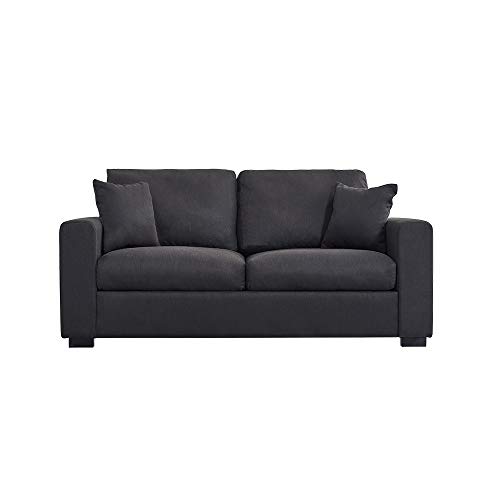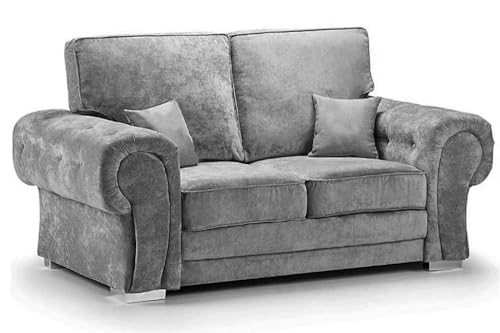Guide To 2 Seater Leather And Fabric Sofa: The Intermediate Guide Towa…
페이지 정보

본문
Choosing Between a 2 seater fabric tub sofa Seater Leather And Fabric Sofa (Www.Demilked.Com)
It can be difficult to choose between leather and fabric when you are searching for a new sofa. This is especially true for those who don't have a lot of furniture experience.
If you have kids or reside in apartments The leather option might be a good fit for you. It is easy to maintain and looks gorgeous in a lot of homes.
Comfort
The sofa is usually the focal point in many people's homes and is an important purchase. You want a sofa that is comfortable to lounge on for hours, looks great, fits with your decor and can endure the test of time. Making a decision between leather and fabric isn't easy However, it is essential to evaluate your needs as well as your lifestyle and budget prior to making a choice.
 Leather is a luxurious, premium material that radiates class and luxury in any home. It is strong and stain-resistant. It is also resistant to pets and children, and can last for a long time when properly cared for. However, it can be more expensive initially and will require regular conditioning to avoid peeling or cracking.
Leather is a luxurious, premium material that radiates class and luxury in any home. It is strong and stain-resistant. It is also resistant to pets and children, and can last for a long time when properly cared for. However, it can be more expensive initially and will require regular conditioning to avoid peeling or cracking.
Fabric 2 Seater Sofas sofas come in a variety of colours, styles and fabrics. They are cheaper than leather ones. They are also more comfortable and more inviting and can feel "broken in" from the start. They may be more susceptible to dust mites or pet hairs, and require frequent cleaning. However, with new technology and high-performance fabrics, there are now hypoallergenic options available.
 The durability of a fabric sofa will depend on the quality of the fabric sofa 2 seater however, most fabrics can expect to last up to 15 years if properly cared for. Regular vacuuming and deep-cleaning will ensure that the fabric is free of stains, odours and dirt. Like leather, they are prone to sagging and flattening over time. A majority of couches made of patterned fabric 2 seater sofa are treated with chemicals to make them stain-resistant and flame-resistant. These couches can release volatile organic chemicals that can cause allergic reactions and alter the quality of air in the indoors.
The durability of a fabric sofa will depend on the quality of the fabric sofa 2 seater however, most fabrics can expect to last up to 15 years if properly cared for. Regular vacuuming and deep-cleaning will ensure that the fabric is free of stains, odours and dirt. Like leather, they are prone to sagging and flattening over time. A majority of couches made of patterned fabric 2 seater sofa are treated with chemicals to make them stain-resistant and flame-resistant. These couches can release volatile organic chemicals that can cause allergic reactions and alter the quality of air in the indoors.
Durability
We often choose sofas with fabrics that are durable, particularly if you have children or pets. It's not necessary to invest an enormous amount of money in the beginning when you're likely to regret it after the very first smudge or claw. You don't want a cheap item that won't hold up to everyday use.
Leather is also extremely tough with a tremendous tear strength. It also lasts up to four times longer than fabric, and is naturally resistant to cracking, fade and flaking over time. It can be conditioned in order to restore its natural oils and make it appear new.
Fabrics are a more affordable alternative and are available in a variety of colors patterns, patterns, and textures to match any interior design. Fabrics are easier to clean and can stand up to some wear and tear. However, they can fade over time and are more vulnerable to moisture.
Microfiber is extremely durable and comes in a variety of colors. However, it might not be as sturdy as genuine leather. It may also not be able to withstand scratches. However, it's an excellent choice for families because of its resistance to spills and stains, and is easy to clean, usually with just a damp cloth.
Suede On the other hand is a challenge to clean and may be more difficult to repair than leather. It's shape can change and appear rough if not regularly maintained. It is also a thin material, so it might not be as durable as sheepskin or cowhide.
Allergens
Fabrics can have a significant effect on allergies. It's important to know how different options perform. Fabrics tend to retain allergens like dust mites pet dander and mold, which can cause symptoms of allergies like rhinitis, hay fever, asthma and eczema. These fabrics are ideal for them to flourish.
Leather is, however isn't susceptible to accumulating these allergens, and can provide consistent comfort throughout the year. It can also cause skin irritation in those who suffer from contact dermatitis or are sensitive to the chemicals used in tanning. To minimize skin reactions, it is important to use vegetable-tanned products and to maintain a regular skincare routine.
Sofas made of leather and fabric offer a high degree of durability, however the material you choose will determine the degree to which it can last over time. A good quality fabric will stand up to daily use without fading or sagging and will endure spills and body oils effortlessly. Modern fabric couches are often equipped with stain-resistant treatment to make cleaning easy.
You may not be able completely to prevent an allergic reaction to the leather in your sofa however, you can to reduce allergens by keeping a lint-roller nearby and clean regularly your living space. This will help to reduce the amount of pet hair, dirt and dust mites that gather on your sofa. If you are still suffering from allergies, you can consider replacing your sofa with a hypoallergenic one. For example, a leather sofa made of vinyl or synthetic leather is less likely to hold dust mites and pet dander. It also can help you breathe more easily.
Scratches
When you are buying a leather sofa, it is important to think about how much wear and tear you can anticipate from it. The finish, color and the quality of the leather are crucial elements in determining how long a couch will last. It is also important to ensure that it is durable enough to withstand spillages and other accidents. This can be accomplished by selecting a sofa with a frame made of wood and high density foam cushions.
Leather is susceptible to being scratched due to various reasons, such as stretching or marking territory, or even recovering stress. Scratches can vary in severity, from minor surface scratches to severe cuts and punctures. Minor scratches can be repaired by using a leather conditioner. This will restore the equilibrium between moisture and oil in the leather and stop it from drying out or cracking. Deep scratches and cut may require a different approach according to the extent of damage.
It is a good idea for cat owners to trim their cat's nails regularly. This will stop them from scratching the sofa. You can also retrain your cat's scratching habit by offering alternatives to scratching surfaces such as cardboard or sisal rope. Another option is to apply a pet-safe furniture polish which can be applied using soft cloths on the affected area.
It is essential to clean your leather sofa regularly and keep it away from heat and direct sunlight, because they dry it out. This can cause it to crack and become difficult to repair and often requires the reupholstery. Make use of a leather conditioner in order to keep the leather supple.
Smell
Leather couches are known to smell different from fabric. It's because leather is porous, and will absorb odors like smoke, body odors or food. The good news is that odors usually dissipate over time, especially if you make use of a fragrance-free, non-toxic and free cleaner.
If the smell is overwhelming It could mean that something is wrong with the foam. This is often caused by chemical off-gassing from petroleum-based polyurethane. If you're worried about this, look for couches that are CertiPUR-US certified latex foams or natural latex.
Another method to determine faux leather is to look for bumps or a texture on the back of a sofa. This is a clear indication that it's bonded instead of genuine top grain leather. You can also conduct an inspection of the interior by tilting the couch to its side to check if you see any exposed upholstery backing. If so detect any visible backing, it's likely a synthetic material like polyurethane or polyester. These will have a very different smell than real leather.
While a leather couch is more prone to picking up smells, the most effective way to avoid this is to regularly clean your sofa. This keeps it looking good and fresh, as well preventing it from becoming stiff or cracked over the years. Begin by vacuuming and dusting your couch, then wiping it down with a dry cloth and baking soda (a good natural way to remove odors). It is recommended to do this at least every small two seater fabric sofa weeks or more to rid your sofa of any dirt and dust build up. Apply leather conditioner to maintain the appearance and color of your sofa.
It can be difficult to choose between leather and fabric when you are searching for a new sofa. This is especially true for those who don't have a lot of furniture experience.
If you have kids or reside in apartments The leather option might be a good fit for you. It is easy to maintain and looks gorgeous in a lot of homes.
Comfort
The sofa is usually the focal point in many people's homes and is an important purchase. You want a sofa that is comfortable to lounge on for hours, looks great, fits with your decor and can endure the test of time. Making a decision between leather and fabric isn't easy However, it is essential to evaluate your needs as well as your lifestyle and budget prior to making a choice.
 Leather is a luxurious, premium material that radiates class and luxury in any home. It is strong and stain-resistant. It is also resistant to pets and children, and can last for a long time when properly cared for. However, it can be more expensive initially and will require regular conditioning to avoid peeling or cracking.
Leather is a luxurious, premium material that radiates class and luxury in any home. It is strong and stain-resistant. It is also resistant to pets and children, and can last for a long time when properly cared for. However, it can be more expensive initially and will require regular conditioning to avoid peeling or cracking.Fabric 2 Seater Sofas sofas come in a variety of colours, styles and fabrics. They are cheaper than leather ones. They are also more comfortable and more inviting and can feel "broken in" from the start. They may be more susceptible to dust mites or pet hairs, and require frequent cleaning. However, with new technology and high-performance fabrics, there are now hypoallergenic options available.
 The durability of a fabric sofa will depend on the quality of the fabric sofa 2 seater however, most fabrics can expect to last up to 15 years if properly cared for. Regular vacuuming and deep-cleaning will ensure that the fabric is free of stains, odours and dirt. Like leather, they are prone to sagging and flattening over time. A majority of couches made of patterned fabric 2 seater sofa are treated with chemicals to make them stain-resistant and flame-resistant. These couches can release volatile organic chemicals that can cause allergic reactions and alter the quality of air in the indoors.
The durability of a fabric sofa will depend on the quality of the fabric sofa 2 seater however, most fabrics can expect to last up to 15 years if properly cared for. Regular vacuuming and deep-cleaning will ensure that the fabric is free of stains, odours and dirt. Like leather, they are prone to sagging and flattening over time. A majority of couches made of patterned fabric 2 seater sofa are treated with chemicals to make them stain-resistant and flame-resistant. These couches can release volatile organic chemicals that can cause allergic reactions and alter the quality of air in the indoors.Durability
We often choose sofas with fabrics that are durable, particularly if you have children or pets. It's not necessary to invest an enormous amount of money in the beginning when you're likely to regret it after the very first smudge or claw. You don't want a cheap item that won't hold up to everyday use.
Leather is also extremely tough with a tremendous tear strength. It also lasts up to four times longer than fabric, and is naturally resistant to cracking, fade and flaking over time. It can be conditioned in order to restore its natural oils and make it appear new.
Fabrics are a more affordable alternative and are available in a variety of colors patterns, patterns, and textures to match any interior design. Fabrics are easier to clean and can stand up to some wear and tear. However, they can fade over time and are more vulnerable to moisture.
Microfiber is extremely durable and comes in a variety of colors. However, it might not be as sturdy as genuine leather. It may also not be able to withstand scratches. However, it's an excellent choice for families because of its resistance to spills and stains, and is easy to clean, usually with just a damp cloth.
Suede On the other hand is a challenge to clean and may be more difficult to repair than leather. It's shape can change and appear rough if not regularly maintained. It is also a thin material, so it might not be as durable as sheepskin or cowhide.
Allergens
Fabrics can have a significant effect on allergies. It's important to know how different options perform. Fabrics tend to retain allergens like dust mites pet dander and mold, which can cause symptoms of allergies like rhinitis, hay fever, asthma and eczema. These fabrics are ideal for them to flourish.
Leather is, however isn't susceptible to accumulating these allergens, and can provide consistent comfort throughout the year. It can also cause skin irritation in those who suffer from contact dermatitis or are sensitive to the chemicals used in tanning. To minimize skin reactions, it is important to use vegetable-tanned products and to maintain a regular skincare routine.
Sofas made of leather and fabric offer a high degree of durability, however the material you choose will determine the degree to which it can last over time. A good quality fabric will stand up to daily use without fading or sagging and will endure spills and body oils effortlessly. Modern fabric couches are often equipped with stain-resistant treatment to make cleaning easy.
You may not be able completely to prevent an allergic reaction to the leather in your sofa however, you can to reduce allergens by keeping a lint-roller nearby and clean regularly your living space. This will help to reduce the amount of pet hair, dirt and dust mites that gather on your sofa. If you are still suffering from allergies, you can consider replacing your sofa with a hypoallergenic one. For example, a leather sofa made of vinyl or synthetic leather is less likely to hold dust mites and pet dander. It also can help you breathe more easily.
Scratches
When you are buying a leather sofa, it is important to think about how much wear and tear you can anticipate from it. The finish, color and the quality of the leather are crucial elements in determining how long a couch will last. It is also important to ensure that it is durable enough to withstand spillages and other accidents. This can be accomplished by selecting a sofa with a frame made of wood and high density foam cushions.
Leather is susceptible to being scratched due to various reasons, such as stretching or marking territory, or even recovering stress. Scratches can vary in severity, from minor surface scratches to severe cuts and punctures. Minor scratches can be repaired by using a leather conditioner. This will restore the equilibrium between moisture and oil in the leather and stop it from drying out or cracking. Deep scratches and cut may require a different approach according to the extent of damage.
It is a good idea for cat owners to trim their cat's nails regularly. This will stop them from scratching the sofa. You can also retrain your cat's scratching habit by offering alternatives to scratching surfaces such as cardboard or sisal rope. Another option is to apply a pet-safe furniture polish which can be applied using soft cloths on the affected area.
It is essential to clean your leather sofa regularly and keep it away from heat and direct sunlight, because they dry it out. This can cause it to crack and become difficult to repair and often requires the reupholstery. Make use of a leather conditioner in order to keep the leather supple.
Smell
Leather couches are known to smell different from fabric. It's because leather is porous, and will absorb odors like smoke, body odors or food. The good news is that odors usually dissipate over time, especially if you make use of a fragrance-free, non-toxic and free cleaner.
If the smell is overwhelming It could mean that something is wrong with the foam. This is often caused by chemical off-gassing from petroleum-based polyurethane. If you're worried about this, look for couches that are CertiPUR-US certified latex foams or natural latex.
Another method to determine faux leather is to look for bumps or a texture on the back of a sofa. This is a clear indication that it's bonded instead of genuine top grain leather. You can also conduct an inspection of the interior by tilting the couch to its side to check if you see any exposed upholstery backing. If so detect any visible backing, it's likely a synthetic material like polyurethane or polyester. These will have a very different smell than real leather.
While a leather couch is more prone to picking up smells, the most effective way to avoid this is to regularly clean your sofa. This keeps it looking good and fresh, as well preventing it from becoming stiff or cracked over the years. Begin by vacuuming and dusting your couch, then wiping it down with a dry cloth and baking soda (a good natural way to remove odors). It is recommended to do this at least every small two seater fabric sofa weeks or more to rid your sofa of any dirt and dust build up. Apply leather conditioner to maintain the appearance and color of your sofa.
- 이전글Guide To Best Luton Auto Locksmith: The Intermediate Guide In Best Luton Auto Locksmith 25.03.31
- 다음글15 Weird Hobbies That'll Make You Smarter At Fold Away Treadmill 25.03.31
댓글목록
등록된 댓글이 없습니다.




 02.6010.5010
02.6010.5010




